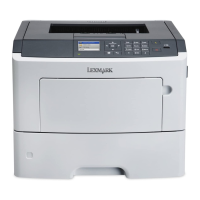Understanding the printer messages
Cartridge, imaging unit mismatch [41.xy]
1 Check if the toner cartridge and imaging unit are both MICR (Magnetic Imaging Content Recording) or
non-MICR supplies.
Note: For a list of supported supplies, see the “Ordering supplies” section of the User's Guide or
visit
www.lexmark.com.
2 Change the toner cartridge or imaging unit so that both are MICR or non‑MICR supplies.
Notes:
• Use MICR toner cartridge and imaging unit for printing checks and other similar documents.
• Use non-MICR toner cartridge and imaging unit for regular print jobs.
Cartridge low [88.xy]
You may need to order a toner cartridge. If necessary, select Continue on the printer control panel to clear
the message and continue printing. For non‑touch‑screen printer models, press
to
confirm.
Cartridge nearly low [88.xy]
If necessary, select Continue on the printer control panel to clear the message and continue printing. For
non‑touch‑screen printer models, press
to
confirm.
Cartridge very low, [x] estimated pages remain [88.xy]
You may need to replace the toner cartridge very soon. For more information, see the “Replacing supplies”
section of the User’s Guide.
If necessary, select Continue on the printer control panel to clear the message and continue printing. For
non‑touch‑screen printer models, press
to confirm.
Change [paper source] to [custom type name] load [orientation]
Try one or more of the following
• Load the correct paper size and type in the tray, verify the paper size and type settings are specified
in the Paper menu on the printer control panel, and then select Finished changing paper. For
non‑touch‑screen printer models, press
to confirm.
• Cancel the print job.
4514-6xx
Diagnostics and troubleshooting
111

